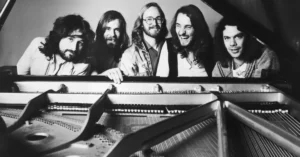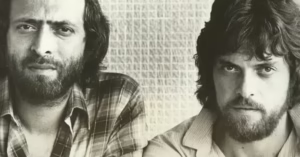Camel: The Melodic Storytellers and Innovators of Progressive Rock
Formation and Origins
Camel emerged from the vibrant British progressive rock scene in 1971, founded in Guildford, England. The original lineup consisted of:
- Andrew Latimer (guitar, vocals)
- Doug Ferguson (bass)
- Andy Ward (drums)
- Peter Bardens (keyboards)
The band formed out of a shared vision to blend the intricate musicianship and ambitious structures of progressive rock with a warm, melodic, and emotionally expressive approach. While many prog bands at the time favored grandiose, complex compositions with heavy theatrics, Camel sought to craft music that was both technically impressive and deeply accessible, focusing on mood, storytelling, and lyrical instrumentals.
Camel. Musical Style and Artistic Vision
Camel’s sound is distinguished by several defining elements:
- Expressive Guitar Work: Andrew Latimer’s guitar playing is central to Camel’s identity. His style combines soaring, lyrical solos with subtle phrasing and tone control, often evoking a deeply emotional atmosphere. His guitar acts as the band’s narrative voice, particularly on their instrumental pieces.
- Rich Keyboard Landscapes: Peter Bardens contributed a lush palette of keyboards, including Hammond organ, Mellotron, and early synthesizers, creating layered, atmospheric textures that enhanced the storytelling nature of their music.
- Complex Yet Accessible Arrangements: Unlike some contemporaries who pursued sheer complexity, Camel balanced intricate time signatures, modulations, and extended suites with memorable melodies and clear song structures. This gave their music a unique accessibility within the progressive rock realm.
- Fusion of Genres: Their style incorporated elements from jazz fusion, folk, classical, and symphonic rock, blending improvisation with composition seamlessly.
- Conceptual and Instrumental Storytelling: Camel often used their albums to tell stories or evoke imagery through music, particularly evident in fully instrumental concept albums like The Snow Goose.
Camel. Evolution and Key Albums
Camel (1973)
Their debut album laid the groundwork, featuring a jazz-inflected progressive rock style with tracks such as “Slow Yourself Down” and “Mystic Queen.” The album introduced the band’s melodic sensibility and instrumental proficiency.
Mirage (1974)
Regarded as one of their finest works, Mirage cemented Camel’s reputation. This album contains extended suites like “Lady Fantasy” and the three-part “Nimrodel/The Procession/The White Rider” — a musical homage to J.R.R. Tolkien’s The Lord of the Rings. The album balances complexity with evocative melodies, establishing a blueprint for melodic prog.
The Snow Goose (1975)
A turning point, this fully instrumental concept album is based on Paul Gallico’s novella of the same name. The Snow Goose is a cohesive, cinematic journey through themes of hope, loss, and nature’s beauty. It showcases Camel’s mastery of narrative purely through music, becoming a landmark album in prog rock history.
Moonmadness (1976)
This album blends personal introspection with the band’s signature melodic prog. Tracks like “Lunar Sea” and “Spirit of the Water” highlight the band’s skill in crafting evocative atmospheres alongside instrumental virtuosity.
Camel. Later Years and Continued Innovation
Following Moonmadness, Camel underwent several lineup changes but continued producing critically acclaimed work:
- Rain Dances (1977) incorporated elements of jazz and funk, with greater focus on groove and rhythmic experimentation.
- Breathless (1978) offered a more streamlined, vocal-centric approach without sacrificing musical sophistication.
- Nude (1981) marked a return to concept albums, telling the story of a Japanese soldier stranded after WWII. The album was praised for its emotional depth and compositional maturity.
- Stationary Traveller (1984) embraced synthesizers and more contemporary production styles while maintaining their progressive roots.
Camel. Band Members and Lineup Changes
Andrew Latimer has remained the consistent driving force behind Camel, shaping its sound and vision throughout decades. Other key members include:
- Peter Bardens (keyboards), whose departure in 1978 marked a significant shift in the band’s style.
- Andy Ward (drums), known for his dynamic and versatile playing.
- Guitarists and keyboardists who joined in later years contributed to the band’s evolving sound.
Despite challenges such as health issues and changing musical landscapes, Camel persisted as a touring and recording band well into the 21st century.
Camel. Legacy and Influence
Camel is often celebrated as a bridge between the intricate musicianship of early prog and the melodic sensibilities that would shape later progressive and art rock bands. Their music has inspired:
- Progressive rock artists who seek to balance virtuosity with emotional accessibility.
- Instrumental and concept album approaches in modern progressive and post-rock scenes.
- A dedicated fanbase appreciative of the band’s consistent artistic integrity and lush soundscapes.
Camel’s contribution to prog rock is both foundational and timeless, earning them a lasting place in the genre’s history.
Conclusion
Camel’s blend of melodic expressiveness, compositional sophistication, and narrative depth sets them apart in the progressive rock pantheon. Their ability to evoke vivid stories and emotions without sacrificing musical complexity makes them essential listening for fans of the genre. From their early days to their later experiments, Camel remains a testament to the power of prog rock as an art form that unites technical skill with heartfelt storytelling.





